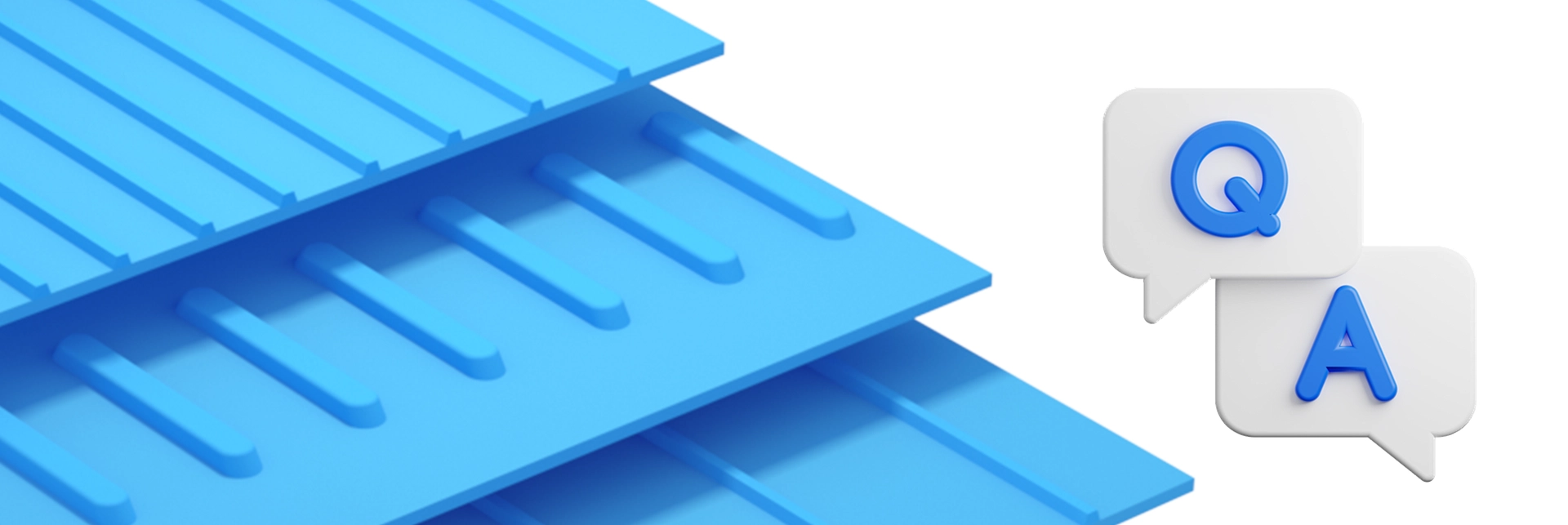FAQ
Our Problem
How to choose a flat belt?
We recommend filling out our questionnaire and sending it to our technical service team. We'll guide you through the selection process to find a working solution.
Where can I get conveyor belt samples?
We are happy to send samples for evaluation - please contact us with your needs using the support page.
Can you provide conveyors and belts?
Cleangen works with a number of specialist conveyor manufacturers and OEMs - we will be happy to connect you with reliable suppliers in your area.
Do you have any information about the chemical resistance of Cleangen materials?
...
Is the Cleangen conveyor belt suitable for all food processing applications?
Basically, Cleangen has solutions for direct contact with all food types. Our belts are manufactured based on machine specifications, environmental conditions, texture, consistency and load as well as required output. In some cases, the choice of acidic foods can be affected by chemical composition and content. We also have many great belt options for these applications.
How to measure belt length/What is Lira?
In short, Li is the "inner length", La is the "outer length", and Lp or Lw is the "pitch or working length". Roughly speaking, La = Li plus 2 times the belt thickness times π (π). Lp is a dimension between La and Li. For thicker belts, including profiles, it is important to specify how the belt is measured, a mistake can be the difference between a belt that works and one that doesn't. We recommend taking careful measurements without tension on the belt. To measure on a simple 2-axis conveyor, place the tensioner so the axes are as close as possible and add half the circumference of the two pulleys (D*π)/2.
Can we heat or high frequency weld all volt materials to each other?
Broadly speaking, it can be divided into three categories, which are used for hand welding and high-frequency welding respectively. Our very hard H, K belts and W guides, materials form a separate category and are compatible with each other. Most other materials can be welded to one another although LT is easier to weld to other LT materials.
Which profile belts provide texture? When do we use them?
Cleangen offers a variety of wear-resistant coating materials, often welded to V-profiles and timing belts. There are various types of grip textures and foam coatings available. Its uses are diverse: stop/start operations, conveying fragile materials such as glass and china, clamping thin plastic packages or conveying bundles of insulation material up gradually sloping slopes. The heat fusion we use ensures the texture will not separate from the belt.
How to assemble the Cleangen conveyor belt on site? Can I insert a section on site?
...
What are the cleaning instructions for Cleangen material?
(1)Cleaning is the responsibility of the factory and is authorized to design an effective cleaning program without damaging the belt.
(2)Compared with combined belts, Volta can save more than 50% of water consumption, cleaning time and working time. Significant savings were also achieved when replacing the fabric base strand tape.
(3)If a factory switches to Cleangen belts without re-evaluating its cleaning regimen, it will not realize the full savings and may damage the belts through excessive use of chemicals
(4)Other types of conveyor belts require higher concentrations of chemicals to clean effectively, but exposure to harsh chemicals can also degrade the belt, creating areas for more bacterial growth. Leaving cleaning chemicals on the conveyor belt for too long before cleaning can also cause damage to the conveyor belt.
(5)When switching to Cleangen, old habits need to be evaluated. New correct cleaning protocols need to be re-evaluated, verified and documented.
(6)Belt manufacturers do not regulate the production process because there are thousands of different foods at different stages of production - "this is the responsibility of the user". Each center has its own standards.
(7)If cleaning with hot water is required, the Cleangen material can be cleaned with hot water when the conveyor belt is stationary, and cannot be opened until the conveyor belt cools down.
Why are thermoplastic materials expensive?
(1)Thermoplastic tapes contain several times more plastic than fabric laminated tapes of the same thickness. To ensure the density and uniformity of the material, the production process is also much slower.
(2)All in all, the price should be comparable to top quality modular belts. Any differences could be explained by local price competition. Crucially, it
(3)A tested and provable fact that thermoplastic tape yields a better return on investment than any other plastic tape type for food contact applications.


